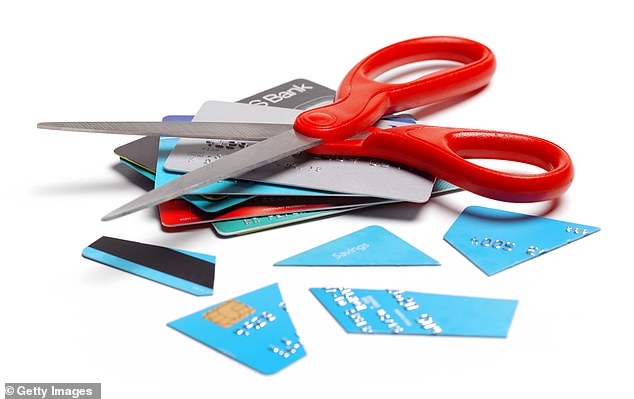
Britain’s 36 million credit card holders are facing the highest interest rates in more than 17 years as providers of some of the most popular cards hike their costs.
Christmas credit card bills are starting to arrive — and, for many, January pay day is still weeks away. And those who can’t pay off their balance in full could be stung with the highest interest rates since records began in June 2006, data from rate scrutineer MoneyfactsCompare shows.
Fourteen consecutive base rate rises by the Bank of England since 2021 have given providers the perfect excuse to drive up the cost of credit card borrowing.
Many providers link their rates to the base rate, which means they automatically increase every time the Bank raises it.


The rises mean a Sainsbury’s customer with the average UK credit card debt of £2,409 would pay £168.63 more interest than last year. A John Lewis customer would pay an additional £144.54 a year
Customers are often given just 30 days’ notice before any increase. Among the most popular cards linked to the base rate — and which have seen interest costs rise as a result — are those from Halifax, Lloyds Bank, MBNA and Barclaycard.
The base rate has risen by 1.75 percentage points over the past year, from 3.5 pc to 5.25 pc. However, the average credit card Annual Percentage Rate (APR) has grown by 4.4 percentage points, says MoneyfactsCompare.
Among the worst offenders is Sainsbury’s, which has hiked its APR by 7 percentage points, from 21.9 pc to 28.9 pc in the past year, according to personal finance website Moneycomms.
John Lewis has raised the APR on its Partnership Card from 21.9 pc to 27.9 pc, a hike of 6 percentage points.
The rises mean a Sainsbury’s customer with the average UK credit card debt of £2,409 would pay £212 more interest than last year. A John Lewis customer would pay an additional £181 a year.
Rachel Springall, of MoneyfactsCompare, warns that the burden on credit card holders is being driven up by a range of factors. ‘It is fuelled by a mix of interest rate hikes, card fee rises, a withdrawal of cards from the market and the increasing size of fees on new cards launched in recent months,’ she says.
Andrew Hagger of Moneycomms adds that providers are pushing up rates, tightening lending criteria and withdrawing cards from the market over fears that borrowers may struggle to pay.
‘They fear that borrowers are more likely to fall into debt as they cannot keep up with their mortgage payments or the higher cost of living,’ he says.
Credit card rates soar
Almost two-thirds of adults have a credit card, according to industry trade body UK Finance.
They can be an invaluable way of spreading the cost of big purchases and spending at more expensive times of the year, such as Christmas. However, if you don’t pay off your balance in full every month and allow balances to grow, costs can quickly escalate.
When interest rates are low, this is more manageable. But credit card rates are variable, so the APR charged can rise or fall at any time.
As a result, average rates have crept up by 9.4 percentage points from 25.4 pc to 34.8 pc in the past decade — nearly double the base rate rise from 0.5 pc to 5.25 pc.
Soaring costs are not the only problem — there are fewer cards available, which is also limiting borrowers’ options.
The balance transfer crunch
Balance transfer cards have typically been used by borrowers to consolidate and pay off outstanding debts. The cards allow customers to pay off debts by transferring everything they owe to one new card.
This means borrowers pay interest on one account instead of several, and these cards often come with 0 pc interest for a set period.
However, while there were 119 balance transfer cards available in January 2014, that’s now dwindled to 60, says MoneyfactsCompare.
The average period before interest is charged has also fallen.
Borrowers who take out a balance transfer card now have 510 days on average before interest is charged — 54 fewer than a year ago. Last year, NatWest cut its longest balance transfer term from 33 to 23 months. Sainsbury’s Bank reduced its deal from 28 to 20 months, and Virgin Money went from 28 to 25 months.
Meanwhile, the average balance transfer fee has risen from 2.2 pc a year ago to 2.37 pc today.
Someone transferring £5,000 last year would typically have paid £110 in fees. Today it costs £118.50. It’s still worth shopping around if your current card is no longer competitive. Halifax, Lloyds and MBNA’s longest balance transfers all have an APR of 23.9 pc. Barclaycard Platinum 18, 20 and 29-month balance transfer cards all have an interest rate of 24.9 pc.
Barclays has the longest term, at 29 months, with a 3.45 pc fee.
NatWest and the Royal Bank of Scotland are offering 13 months with no fee.
And personal loan costs are rising too
The cost of taking out a personal loan has increased by almost a third in the past year — and a number of lenders are raising rates by more than the increase to the base rate.
A typical adult in the UK now has £4,125 of unsecured debt, £230 more than a year ago, according to The Money Charity.
A borrower with a loan of this size from M&S a year ago would have got a rate of 6.5 pc. The same loan now has a rate of 9.9 pc, costing £233 more over three years.
Industry trade body UK Finance says the interest rates lenders charge are determined by a number of factors.
As interest rates rise, it becomes more expensive for banks to raise funds to lend to customers, which can push up rates.
Lenders will also charge a higher rate if they think there is a greater risk that the customer will not repay their loan in full.
On personal loans, the rate you are offered depends on the amount you borrow, with smaller loans usually the most expensive.
For example, borrowers taking out a loan of up to £1,999 from Tesco Bank will be offered a representative APR of 14.8 pc.
Yet if the same customer borrowed between £2,000 and £25,000, the APR would fall to 6.1 pc.
Meanwhile, on loans of up to £1,999, Santander offers 13.5 pc APR, falling to 6.3 pc on loans of £2,000 to £25,000.
Economists expect the Bank of England to start cutting interest rates by the middle of this year, and personal loan rates may fall slightly by the beginning of 2025.
Most personal loans have a fixed rate, so the rate you are charged will not change for the duration of the loan.
The best low rate credit cards
There are still some credit cards and loans with lower rates on the market.
‘Interest rate rises should encourage borrowers to compare and switch deals,’ says Rachel Springall of MoneyfactsCompare.
TSB’s Advance credit card has the lowest rate of any provider, at 12.9 pc, with 0 pc interest on purchases and balance transfers for the first three months. After that, all balances transferred onto the card incur a 5 pc fee.
A borrower with the average level of credit card debt would be £743 better off after a year if they transferred their balance to this card instead of continuing with one that charges a typical APR.
The second most competitive is the Co-operative Bank 0 pc balance transfer credit card, which has a rate of 20.6 pc with 0 pc interest for the first four months.
Transferring their balance to this card would save the same borrower £634 a year.
However, applying for a new credit card will leave a mark on your credit report, whether you’re accepted or not. Therefore you should avoid making more than one application at any time or it looks as though you may be struggling and lenders may be wary of giving you money you can’t repay.
You can also use an online credit card eligibility calculator to find out if you’re likely to be accepted for a card before applying, which won’t affect your credit score.









